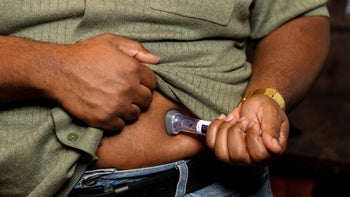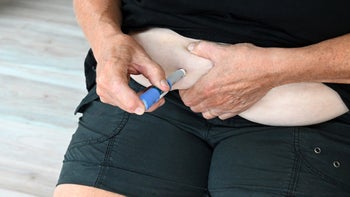
Zepbound (Tirzepatide) Dosages for Weight Loss and Sleep Apnea: Your GoodRx Guide
Key takeaways:
Zepbound (tirzepatide) is a once-weekly injection that’s FDA approved for chronic weight management in adults. It’s also approved to treat sleep apnea in adults considered obese.
The typical starting Zepbound dosage for weight loss is 2.5 mg once a week for 4 weeks. At week 5, your prescriber will likely raise your dosage to 5 mg once a week. If needed, your dosage can be increased again starting at week 9. The recommended maintenance (steady) Zepbound dosage for weight loss is 5 mg, 10 mg, or 15 mg once a week.
Zepbound dosages for sleep apnea follow the same schedule as for weight loss when you first start it. But the recommended maintenance dosage is 10 mg or 15 mg once a week.
Zepbound dosages shouldn’t be increased by more than 2.5 mg every 4 weeks. The maximum recommended Zepbound dosage for weight loss and sleep apnea is 15 mg once a week.
Table of contents

Weight-loss medications are all over the news. For decades we had limited treatments, but several injectable medications have provided new options for chronic weight management. Zepbound (tirzepatide) is one of these medications.
Tirzepatide was originally FDA approved for Type 2 diabetes under the brand name Mounjaro. But studies also showed that tirzepatide could result in significant weight loss when paired with routine exercise and a low-calorie diet. This led to Zepbound’s approval for weight loss. Then in late 2024, the FDA approved Zepbound to treat sleep apnea in adults considered obese.
Taking the right dosage is essential when it comes to taking any medication. With some medications, such as Zepbound, it can take a few weeks to reach the maintenance (steady) dose. Below, we’ll discuss the recommended Zepbound dosages for weight loss and sleep apnea. But you should follow your healthcare care team’s instructions if they’re different from what’s described here.
Note: Zepbound is approved only for use in adults. So we won’t cover dosages for children in this guide.
What’s the typical Zepbound (tirzepatide) dosage for weight loss?
You should inject Zepbound once a week on the same day each week. It comes as a prefilled, single-dose injector pen that’s ready to use. Certain doses also come as single-dose vials that you’ll use a separate syringe to draw up.
Get Lantus For Less
With GoodRx, pay no more than $35 for a 30 day supply of Lantus.

GoodRx is NOT insurance. GoodRx Health information and resources are reviewed by our editorial staff with medical and healthcare policy and pricing experience. See our editorial policy for more detail. We also provide access to services offered by GoodRx and our partners when we think these services might be useful to our visitors. We may receive compensation when a user decides to leverage these services, but making them available does not influence the medical content our editorial staff provides.
Once a healthcare professional shows you how to inject Zepbound, you can inject your doses at home. Alternatively, a caregiver could administer Zepbound if you’re unable or don’t want to inject yourself.
You can inject doses into the skin of your stomach, thigh, or upper arm. For many people, it’s easiest to self-inject Zepbound into the stomach. Just make sure to change the area where you inject with each dose. This helps you get the full dose and reduces irritation at the injection site. After each injection, you should discard the pen in a sharps container.
Zepbound pens are available in the following doses:
2.5 mg
5 mg
7.5 mg
10 mg
12.5 mg
15 mg



As of January 2025, single-dose vials are available in the 2.5 mg and 5 mg doses.
Zepbound dosage schedule
The recommended starting Zepbound dosage for weight loss and sleep apnea is 2.5 mg once a week for 4 weeks. This low dosage helps limit digestive side effects, such as nausea and diarrhea, while your body adjusts to the medication.
On week 5, your healthcare care team will likely raise your Zepbound dosage to 5 mg once a week for another 4 weeks. At week 9, your care team may raise your dosage again, depending on why you’re using Zepbound and your response to it.
The recommended maintenance Zepbound dosage for weight loss is 5 mg, 10 mg, or 15 mg once a week. The recommended maintenance dosage for sleep apnea is 10 mg or 15 mg once a week.
It’s recommended to increase dosages by no more than 2.5 mg at once. And there should be at least 4 weeks between each adjustment. The maximum Zepbound dosage for weight loss and sleep apnea is 15 mg once a week.
For ease of reference, we’ve included a Zepbound dosage chart.
Treatment week | Recommended Zepbound (tirzepatide) dosage for weight loss and sleep apnea |
Weeks 1–4 | 2.5 mg once a week |
Weeks 5–8 | 5 mg once a week |
Week 9 and beyond | For weight loss: Can raise dosage again, if needed, by no more than 2.5 mg at once. Dosage increases should be separated by at least 4 weeks. For sleep apnea: Raise dosage to 7.5 mg once a week. At week 13, raise it again to 10 mg once a week. Starting at week 17, your dose can be raised again, if needed, by no more than 2.5 mg at once. Dosage increases should be separated by at least 4 weeks. |
Maximum dosage | 15 mg once a week |
Recommended maintenance dosage for weight loss | 5 mg, 10 mg, or 15 mg once a week |
Recommended maintenance dosage for sleep apnea | 10 mg or 15 mg once a week |
Are there any dosage adjustments for health conditions or interactions?
No, there aren’t any recommended Zepbound dosage adjustments for people with certain health conditions, such as kidney or liver disease. But this doesn’t mean your healthcare team won’t adjust your dosage once you get started with Zepbound.
Tips for success: Read these pharmacist-backed tips for using Zepbound, so you can get the most out of your medication.
What to expect: Learn about notable Zepbound side effects — from nausea to diarrhea — and how to manage them.
Cost considerations: Find out how much Zepbound costs (with and without insurance), plus ways you can save.
In certain situations, they may consider lowering your dosage. For example, if you experience bothersome side effects, lowering your Zepbound dosage may help you tolerate it better. But keep in mind that 5 mg per week is considered the lowest effective dosage for weight loss. And 10 mg per week is the lowest effective dose for sleep apnea. It’s likely your healthcare team will suggest alternatives if this dosage causes too many side effects.
There aren’t reports of drug interactions affecting Zepbound. But Zepbound slows the movement of food and medication through your digestive tract. So it could delay the absorption of oral medications. In some cases, such as with birth control pills, Zepbound could make them less effective.
Zepbound can also cause low blood glucose (sugar). On its own, the risk of this side effect is low. But when combined with other medications that lower blood glucose, especially insulin, this risk goes up.
Talk to your healthcare team about the best way to handle these interactions. And be sure to review your current medication list. They may suggest adjustments to one or more of your medications.
What happens if you miss a dose of Zepbound?
If you missed your scheduled dose of Zepbound, don’t fret. There are directions to get back on track. But how you handle a missed dose depends on how much time has passed.
If it’s been less than 4 days (96 hours) since your missed dose, inject Zepbound as soon as possible. Then inject your next dose at the usual time.
If it’s been more than 4 days, skip the missed dose. Wait until your next regularly scheduled injection day, and inject your usual Zepbound dose. Then go back to your regular weekly injection schedule. Don’t double up or inject extra doses to make up for a missed one.
It can be tough to remember medications when you’re not taking them every day. But there are plenty of tips on how to remember your doses. You can try setting an alarm or downloading a medication reminder app on your smartphone. GoodRx’s Medicine Cabinet is an example of a free medication reminder app.
Can you change your Zepbound injection day?
Yes, you can change your Zepbound injection day if needed. But there are guidelines to follow.
When changing injection days, the doses of Zepbound should be at least 3 days (72 hours) apart. For example, if your usual injection day is Saturday, you can switch to Tuesday (or another day later that week).
Speak with your healthcare care team before changing your Zepbound injection day. They can provide you with a safe schedule based on your situation.
Good to know: It’s best to keep your Zepbound injection day consistent. Using the medication too often can raise your risk of side effects. It can also lead you to run out of medication sooner than expected. If you find yourself needing to change injection days frequently, speak with your healthcare team.
What should you do if you take too much Zepbound?
There isn’t much information on what can happen if a person injects too much Zepbound. But you may be more likely to experience side effects. Common side effects are gastrointestinal related and include diarrhea, nausea, and stomach pain.
Too much Zepbound may also cause hypoglycemia. As mentioned above, if you’re also prescribed other glucose-lowering medications, your risk of this side effect may be higher.
If you think you’ve injected too much Zepbound, contact the healthcare professional who prescribed it. You can also call Poison Control at 1-800-222-1222 or contact them online. They can advise you on how to handle any symptoms you may be having from injecting too much Zepbound. If your symptoms feel severe or life-threatening, go to an ER or call 911.
How to save on Zepbound
There are ways to save on Zepbound, which is available as a brand-name medication. If you have commercial insurance, you may be eligible to pay as little as $25 per prescription through the manufacturer’s copay savings program. If your plan doesn’t cover Zepbound, you may be able to pay $550 for a 30-day supply. Lower-cost single-dose vials are also available through LillyDirect for $399 (2.5 mg) and $549 (5 mg) per month.
Frequently asked questions
There are two main reasons for increasing your Zepbound dose. When you first start using it, your prescriber will raise your dose from 2.5 mg to 5 mg over the first few weeks. This helps you adjust to the medication and helps limit side effects. Your healthcare team may also suggest increasing your Zepbound dose up to a maximum of 15 mg if you’re not meeting your weight-loss or sleep apnea goals.
Your maintenance dose of Zepbound for weight loss depends on your response to the medication. After you’ve used the 5 mg weekly dose for at least 4 weeks, your prescriber should follow up with you. They’ll check your body weight and ask you about side effects. Your maintenance dose will be the one that provides ideal weight loss with minimal side effects.
In general, higher Zepbound doses are more effective. In clinical trials, the 15 mg dose of Zepbound led to greater weight loss than the 5 mg and 10 mg doses. But the risk of side effects also goes up with higher doses. Not everyone can tolerate the 15 mg dose of Zepbound. The 5 mg and 10 mg doses are still very effective for weight loss and may cause fewer side effects.
Most people need to use Zepbound long term to maintain weight loss. It’s common to regain some of the weight you lost after stopping the medication. Similarly, sleep apnea is a chronic condition. Stopping Zepbound may cause your symptoms to worsen or return. If you’re interested in stopping Zepbound, discuss it with your prescriber first.
No, compounded tirzepatide is not the same as Zepbound. Compounded medications are not tested for safety and effectiveness like FDA-approved products. There are potential safety issues with using compounded tirzepatide. Talk with your healthcare team about these risks before trying it.
The bottom line
The typical starting Zepbound (tirzepatide) dosage for weight loss and sleep apnea is 2.5 mg injected once a week for 4 weeks. At week 5, you’ll likely raise your dosage to 5 mg once a week. At week 9, your healthcare team may raise your dosage again, depending on why you’re using Zepbound and your response to it.
The recommended maintenance dosage of Zepbound for weight loss is 5 mg, 10 mg, or 15 mg once a week. The recommended maintenance dosage for sleep apnea is 10 mg or 15 mg once a week. The maximum Zepbound dosage is 15 mg once a week.
You shouldn’t raise your Zepbound dose by more than 2.5 mg at once. And there should be at least 4 weeks between increases. Following the recommended Zepbound dosage schedule helps limit common side effects, such as nausea and diarrhea.
Why trust our experts?



References
Aronne, L. J., et al. (2023). Continued treatment with tirzepatide for maintenance of weight reduction in adults with obesity: The SURMOUNT-4 randomized clinical trial. Journal of the American Medical Association.
Eli Lilly and Company. (2024). FDA approves Zepbound® (tirzepatide) as the first and only prescription medicine for moderate-to-severe obstructive sleep apnea in adults with obesity.
Eli Lilly and Company. (2024). Zepbound - tirzepatide injection, solution [package insert].
Farzam, K., et al. (2024). Tirzepatide. StatPearls.
Jastreboff, A. M., et al. (2022). Tirzepatide once weekly for the treatment of obesity. The New England Journal of Medicine.
Lilly. (2024). Lilly releases Zepbound (tirzepatide) single-dose vials, expanding supply and access for adults living with obesity.
MedlinePlus. (2023). Tirzepatide injection.
Mishra, R., et al. (2023). Adverse events related to tirzepatide. Journal of the Endocrine Society.
U.S. Food and Drug Administration. (2023). FDA approves new medication for chronic weight management.
Was this page helpful?
Related Articles
Browse medications
View AllResearch prescriptions and over-the-counter medications from A to Z, compare drug prices, and start saving.

























